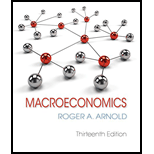
Macroeconomics
13th Edition
ISBN: 9781337617390
Author: Roger A. Arnold
Publisher: Cengage Learning
expand_more
expand_more
format_list_bulleted
Question
Chapter 8.3, Problem 3ST
To determine
Describe the workers’ misperceptions for SRAS curve with an explanation.
Expert Solution & Answer
Want to see the full answer?
Check out a sample textbook solution
Students have asked these similar questions
simple steps on how it should look like on excel
Consider options on a stock that does not pay dividends.The stock price is $100 per share, and the risk-free interest rate is 10%.Thestock moves randomly with u=1.25and
d=1/u
Use Excel to calculate the premium of a10-year call with a strike of $100.
Compute the Fourier sine and cosine transforms of f(x) = e.
Chapter 8 Solutions
Macroeconomics
Ch. 8.2 - Prob. 1STCh. 8.2 - Prob. 2STCh. 8.2 - Prob. 3STCh. 8.3 - Prob. 1STCh. 8.3 - Prob. 2STCh. 8.3 - Prob. 3STCh. 8.5 - Prob. 1STCh. 8.5 - Prob. 2STCh. 8 - Prob. 1QPCh. 8 - Prob. 2QP
Ch. 8 - Prob. 3QPCh. 8 - Prob. 4QPCh. 8 - Prob. 5QPCh. 8 - Prob. 6QPCh. 8 - Prob. 7QPCh. 8 - Prob. 8QPCh. 8 - Prob. 9QPCh. 8 - Prob. 10QPCh. 8 - Prob. 11QPCh. 8 - Prob. 12QPCh. 8 - Prob. 13QPCh. 8 - Prob. 14QPCh. 8 - Prob. 15QPCh. 8 - Prob. 16QPCh. 8 - Prob. 17QPCh. 8 - Prob. 18QPCh. 8 - Prob. 19QPCh. 8 - Prob. 20QPCh. 8 - Prob. 21QPCh. 8 - Prob. 1WNGCh. 8 - Prob. 2WNGCh. 8 - Prob. 3WNGCh. 8 - Prob. 4WNGCh. 8 - Prob. 5WNGCh. 8 - Prob. 6WNG
Knowledge Booster
Similar questions
- 17. Given that C=$700+0.8Y, I=$300, G=$600, what is Y if Y=C+I+G?arrow_forwardUse the Feynman technique throughout. Assume that you’re explaining the answer to someone who doesn’t know the topic at all. Write explanation in paragraphs and if you use currency use USD currency: 10. What is the mechanism or process that allows the expenditure multiplier to “work” in theKeynesian Cross Model? Explain and show both mathematically and graphically. What isthe underpinning assumption for the process to transpire?arrow_forwardUse the Feynman technique throughout. Assume that you’reexplaining the answer to someone who doesn’t know the topic at all. Write it all in paragraphs: 2. Give an overview of the equation of exchange (EoE) as used by Classical Theory. Now,carefully explain each variable in the EoE. What is meant by the “quantity theory of money”and how is it different from or the same as the equation of exchange?arrow_forward
- Zbsbwhjw8272:shbwhahwh Zbsbwhjw8272:shbwhahwh Zbsbwhjw8272:shbwhahwhZbsbwhjw8272:shbwhahwhZbsbwhjw8272:shbwhahwharrow_forwardUse the Feynman technique throughout. Assume that you’re explaining the answer to someone who doesn’t know the topic at all:arrow_forwardUse the Feynman technique throughout. Assume that you’reexplaining the answer to someone who doesn’t know the topic at all: 4. Draw a Keynesian AD curve in P – Y space and list the shift factors that will shift theKeynesian AD curve upward and to the right. Draw a separate Classical AD curve in P – Yspace and list the shift factors that will shift the Classical AD curve upward and to the right.arrow_forward
- Use the Feynman technique throughout. Assume that you’re explaining the answer to someone who doesn’t know the topic at all: 10. What is the mechanism or process that allows the expenditure multiplier to “work” in theKeynesian Cross Model? Explain and show both mathematically and graphically. What isthe underpinning assumption for the process to transpire?arrow_forwardUse the Feynman technique throughout. Assume that you’re explaining the answer to someone who doesn’t know the topic at all: 15. How is the Keynesian expenditure multiplier implicit in the Keynesian version of the AD/ASmodel? Explain and show mathematically. (note: this is a tough one)arrow_forwardUse the Feynman technique throughout. Assume that you’re explaining the answer to someone who doesn’t know the topic at all: 13. What would happen to the net exports function in Europe and the US respectively if thedemand for dollars rises worldwide? Explain why.arrow_forward
arrow_back_ios
SEE MORE QUESTIONS
arrow_forward_ios
Recommended textbooks for you
 Economics (MindTap Course List)EconomicsISBN:9781337617383Author:Roger A. ArnoldPublisher:Cengage Learning
Economics (MindTap Course List)EconomicsISBN:9781337617383Author:Roger A. ArnoldPublisher:Cengage Learning





Economics (MindTap Course List)
Economics
ISBN:9781337617383
Author:Roger A. Arnold
Publisher:Cengage Learning




